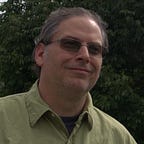The Why of the Forest
Cutting Systems Development to the Essentials
Trees are sanctuaries. Whoever knows how to speak to them, whoever knows how to listen to them, can learn the truth. They do not preach learning and precepts, they preach, undeterred by particulars, the ancient law of life.
— Herman Hesse
There is an issue of professional knowledge domains — things like science, computer science, economics, politics — that is a common plagues for humanity: what to call things we work with or build with.
The initiate idea for The Accepted Forest (tAF) was the realization that there was such an argument between certain botanists about which names of species of Elm apply to which instances of botany that the botanists themselves received a name: pteleologists. (Why, Elm? Because that was the language I was evaluating at the time.) Myself not being a botanist was finding it interesting that so many names of kinds of “Elm” trees were so hotly debated. There were discussions and debates of the “accepted name” for each species in a particular region. The problem with these perpetual debates with biology is that biology is a somewhat continuous process that is very slow to our eyes. A tree of a particular species may live decades and propagations of any particular tree may have genetic changes or epigenetic changes that lie, unobserved, for decades beyond the original tree.
Hmm, where else has that ever happened in computer science? “Old” mutations come back as “new” ideas — and the woodsmen talk about which are better or worse or what things should be called.
Ah, yes, in the perpetual utility of language wars where one defends Green languages versus Blue ideologies to great personal stress and strife. Is your programming language “functional” or “lazy” or “strict” or “strong typed” or “weak typed.” Are you writing in a “Blub” language or “Not-Blub” language. Wait, what’s a “Blub” language? It turns out to be the language you most prefer — and passionately defend until it becomes a problem.
Paul Graham describes the problem of the expert “Blub Programmer” proficient with the “most powerful language” of “Blub” in his essay “Beating the Averages”:
As long as our hypothetical Blub programmer is looking down the power continuum, he knows he’s looking down. Languages less powerful than Blub are obviously less powerful, because they’re missing some feature he’s used to. But when our hypothetical Blub programmer looks in the other direction, up the power continuum, he doesn’t realize he’s looking up. What he sees are merely weird languages. He probably considers them about equivalent in power to Blub, but with all this other hairy stuff thrown in as well. Blub is good enough for him, because he thinks in Blub.
This problem of naming, which grew into language-blindness can be extended further.
Another English idiom rings into the Why of tAF: “He can’t see the forest for the trees” — or in other words, one gets tied up into only the specifics of a situation and fails to see larger, general principles. tAF wants to help bring this ability of stepping up your ability to perceive in programming and systems to a higher level. But, for functional programming at least, you have to be able to code a tree to understand how to code a forest — and still knowing that potentially there could be many other “acceptable” trees that may be present in the “acceptable” forest.
It does not mandate a particular programming language, methodology, operating system, or monetization model except those that make systems and people better at what they need or want to do — with a recognition that it is possible to over-complicate anything. The “Why” of The Acceptable Forest is the teach the understanding of the “What” and the “How” of systems can be fluid without the rancor of processes without reflection. The “How” of systems can show that they are imperfect and can be improved upon without insult or without malice. The Acceptable Forest is not the Proven Forest because people are imperfect — although at times, capable of the purest expressions of thought and inspiration.
Let’s all go forth and stumble and stroll through the Acceptable Forest to see what we can forage for our minds, our tools and our systems — and we all may find ourselves with surplus beyond imagination.
Simon Janes writes challenging software and prose for psychological pleasure and was certifiably “incorrigible” according to his 9th Grade GT English teacher.
